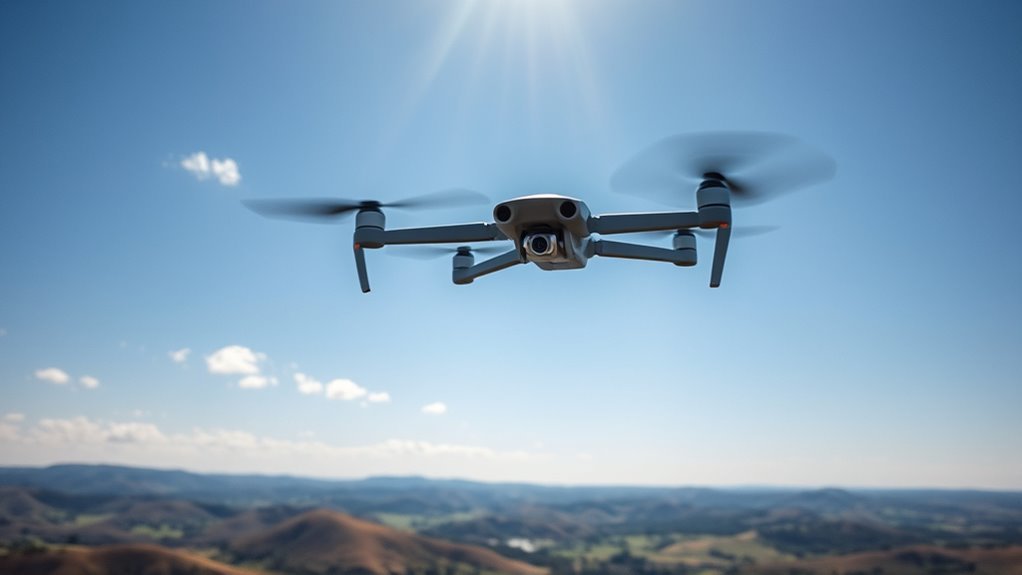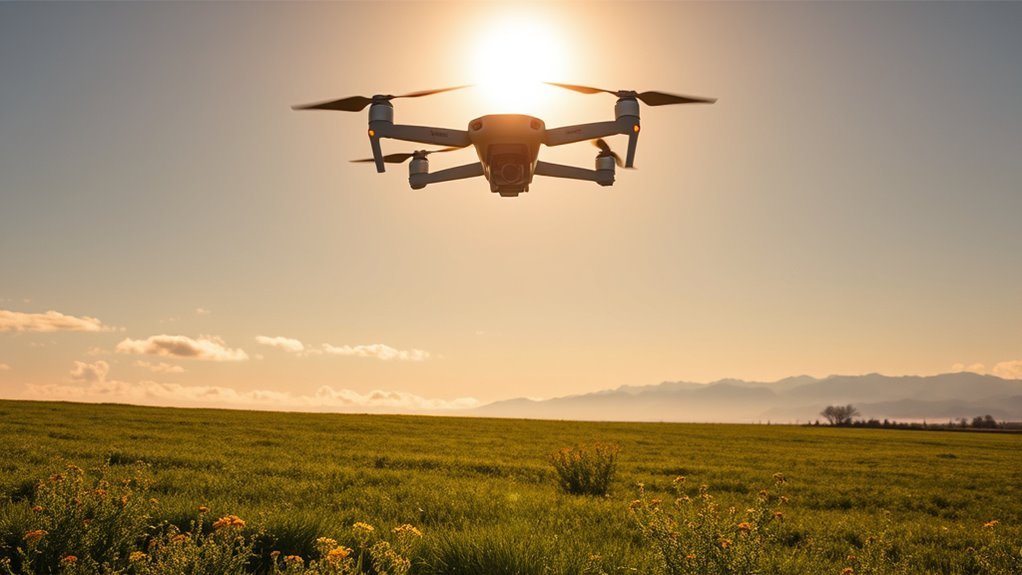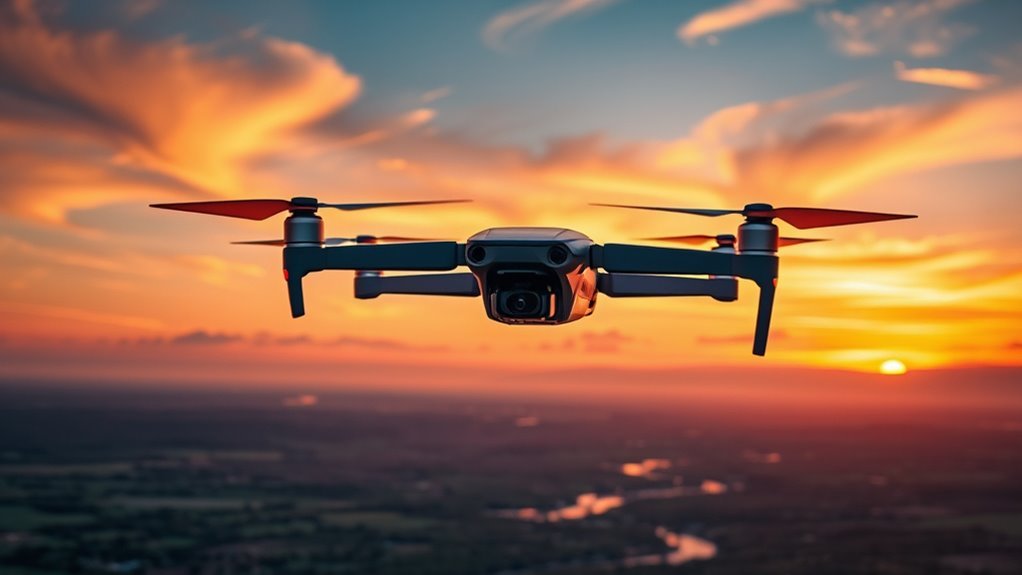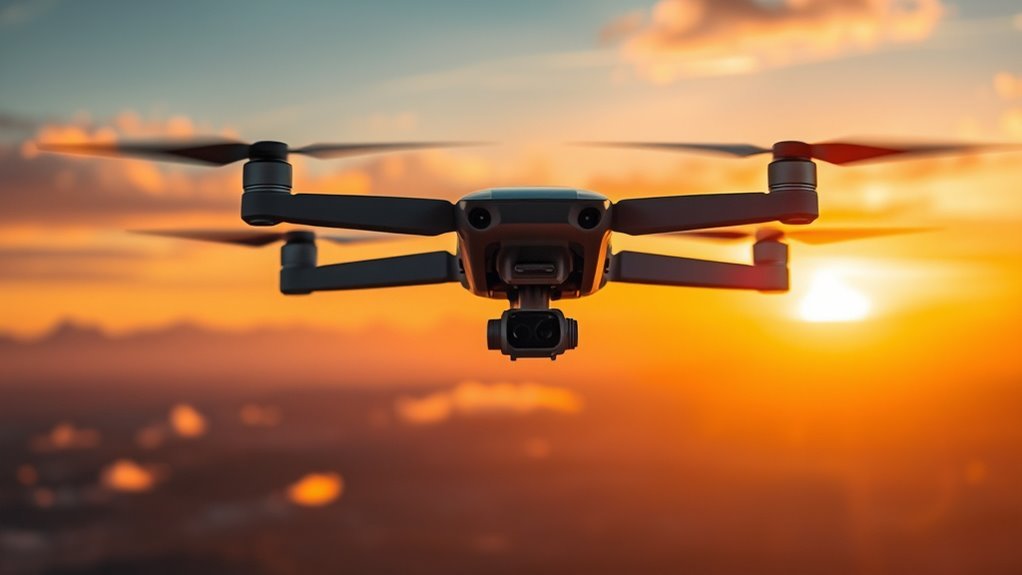You can typically expect consumer drones to stay in the air for 20 to 30 minutes, depending largely on battery type, payload weight, and environmental conditions like wind and temperature. Professional or surveying drones extend this to 40-70 minutes by using larger batteries and efficient designs. Flight time is heavily influenced by battery capacity and power management. Understanding these factors helps you optimize flight performance, and exploring advanced tech and strategies can further enhance your drone’s airtime.
Factors Affecting Drone Flight Time

Although drones vary widely in design and purpose, several key factors consistently influence how long they can stay airborne. You’ll find that battery types greatly affect flight duration—lithium-polymer (LiPo) batteries, for example, offer high energy density and lightweight advantages, enabling longer flights compared to older nickel-metal hydride batteries. Equally critical is weight distribution; uneven or excessive payloads increase power consumption, reducing airtime. Properly balancing the drone minimizes energy waste and optimizes motor efficiency, allowing you greater freedom to explore. Environmental conditions also play a role, but focusing on battery technology and precise weight distribution offers you the most control over flight time. By carefully selecting and configuring these elements, you maximize your drone’s airborne potential without compromise.
Typical Flight Times for Different Drone Types

You’ll find that consumer drones typically offer flight times between 20 to 30 minutes, balancing battery capacity and weight. Professional drones extend endurance, often reaching 40 to 60 minutes due to larger batteries and efficient power management. Racing drones, prioritizing speed and agility, usually have shorter battery lives around 5 to 10 minutes to maintain peak performance.
Consumer Drone Flight Durations
When evaluating consumer drones, flight duration is a critical parameter influenced by battery capacity, motor efficiency, and drone weight. Most consumer drones offer flight times between 15 to 30 minutes, constrained by current lithium-polymer battery technology. Lightweight quadcopters typically achieve closer to 20 minutes, while heavier models with advanced features often sacrifice endurance for added capability. Drone regulations also indirectly affect flight duration by imposing altitude and distance limits, prompting manufacturers to optimize energy use within legal boundaries. You’ll notice that improvements in battery energy density and motor design gradually extend flight times, but inherent trade-offs remain: increasing battery size boosts endurance but adds weight, reducing efficiency. Understanding these factors helps you select a drone that balances your desire for prolonged flight with practical constraints dictated by technology and regulation.
Professional Drone Endurance
Moving beyond consumer models, professional drones are engineered to meet more demanding operational requirements, which directly impact their endurance capabilities. You’ll notice that long range capabilities and lightweight designs are critical factors enabling extended flight times. Depending on the drone type, flight durations vary considerably, balancing payload and energy efficiency for mission flexibility.
| Drone Type | Flight Time (Minutes) | Key Features |
|---|---|---|
| Surveying UAV | 45 – 60 | Long range, lightweight |
| Agricultural UAV | 30 – 50 | High payload, robust |
| Inspection UAV | 40 – 55 | Precise sensors, stable |
| Delivery Drone | 20 – 40 | Moderate range, durable |
| Mapping Drone | 50 – 70 | Extended flight, lightweight |
Understanding these specs helps you select a drone that maximizes your operational freedom.
Racing Drone Battery Life
Although racing drones prioritize speed and agility over endurance, understanding their battery life is essential for optimizing performance during competitive flights. In drone racing, battery optimization directly impacts your ability to maintain peak velocity and maneuverability. Typical flight times vary due to battery capacity, motor efficiency, and flight style:
- Standard 4S LiPo batteries offer 3-5 minutes of high-intensity flight, balancing power and weight.
- Advanced 6S setups can reduce flight time to 2-4 minutes but provide greater thrust for aggressive maneuvers.
- Battery management, including voltage monitoring and pre-race conditioning, extends usable flight duration.
How Battery Capacity Influences Flight Duration

Battery capacity plays an essential role in determining how long your drone can remain airborne. The total milliampere-hour (mAh) rating directly correlates with energy storage, influencing flight duration. Different battery types, such as lithium-polymer (LiPo) and lithium-ion, offer varying energy densities; LiPo batteries provide higher discharge rates vital for dynamic maneuvers but may weigh more, affecting efficiency. Effective energy management is vital—balancing power consumption with capacity optimizes flight time without compromising performance. You must consider both the battery’s weight and its discharge curve to maximize endurance. Understanding these technical factors allows you to select or customize batteries that grant your drone extended freedom in the air, pushing boundaries while maintaining operational reliability and safety.
The Impact of Weather Conditions on Drone Performance
You’ll notice that wind can greatly alter your drone’s stability and increase power consumption, shortening flight time. Temperature extremes impact battery efficiency, with cold reducing capacity and heat accelerating degradation. Additionally, rain and moisture pose serious risks to electronic components, potentially causing malfunctions or failures mid-flight.
Wind Effects on Flight
When flying a drone, wind conditions can greatly influence its stability and flight time. Understanding wind resistance and turbulence effects is essential to maximizing your drone’s airborne duration. Here’s what you should consider:
- Wind Resistance: As wind speed increases, your drone’s motors work harder to maintain position, consuming more battery power and shortening flight time.
- Turbulence Effects: Gusty or erratic wind patterns cause sudden shifts in drone orientation, forcing constant adjustments that drain energy rapidly.
- Flight Path Stability: Flying against strong winds reduces progress speed, while tailwinds may increase it but complicate control precision, affecting overall endurance.
Temperature Influence on Batteries
Besides wind, temperature plays a significant role in how long your drone can stay airborne by directly affecting battery efficiency. Battery chemistry is sensitive to temperature fluctuations, with lithium polymer (LiPo) cells commonly used in drones exhibiting ideal performance within specific temperature thresholds—typically between 20°C and 40°C. When temperatures drop below these thresholds, internal resistance rises, reducing discharge capacity and flight time. Conversely, excessive heat accelerates chemical degradation and risks thermal runaway, compromising battery longevity and safety. To maximize your drone’s flight duration, you need to monitor ambient temperature and avoid operating in extreme cold or heat. Understanding these thermal limitations allows you to plan flights that align with battery chemistry constraints, ensuring consistent power output and the freedom to explore without unexpected power loss.
Rain and Moisture Risks
Although drones are designed to withstand various environmental factors, exposure to rain and moisture presents significant risks that can drastically reduce flight performance and safety. You need to understand how moisture damage impacts your drone’s electronics and mechanics. Here’s what you should consider for effective rain precautions:
- Water Intrusion: Even minor moisture can short-circuit internal components, leading to immediate failure or long-term corrosion.
- Sensor Impairment: Rain droplets interfere with optical and ultrasonic sensors, reducing navigation accuracy and stability.
- Battery Efficiency: Moisture reduces battery efficiency by causing voltage fluctuations and increasing internal resistance.
To maximize your drone’s airtime freedom, avoid flying in wet conditions or invest in waterproofing solutions. Proper rain precautions extend operational lifespan and maintain consistent performance, ensuring you stay airborne longer without risking costly damage.
Tips for Extending Your Drone’s Air Time
Since battery capacity and environmental factors primarily limit drone flight time, improving these elements is vital to extending your drone’s air time. Start with diligent battery maintenance: regularly calibrate, avoid deep discharges, and store batteries at ideal temperatures to preserve capacity. Next, minimize weight reduction by removing unnecessary accessories or payloads, which directly decreases power consumption. Enhance propeller efficiency by selecting designs tailored for your drone’s motor and typical flight conditions, reducing drag and increasing lift. Finally, meticulous flight planning is essential—plot routes that avoid aggressive maneuvers and strong headwinds, conserving energy. By combining these strategies, you maximize your drone’s operational freedom, enabling longer, more efficient flights without relying on advanced technologies or hardware modifications.
Advanced Technologies Improving Drone Flight Time
While maintaining batteries and optimizing flight conditions can greatly extend your drone’s air time, technology continues to push these boundaries further. Advanced innovations in battery technology and energy efficiency are key to facilitating longer flights, letting you explore without frequent interruptions. Here are three cutting-edge advancements improving drone endurance:
- Solid-State Batteries: These offer higher energy density and safer operation, enabling drones to fly longer on a single charge.
- Lightweight Composite Materials: Reducing drone weight directly enhances energy efficiency, allowing your drone to stay airborne longer with less power.
- Smart Power Management Systems: These dynamically adjust energy consumption in real-time, optimizing battery use based on flight conditions.

